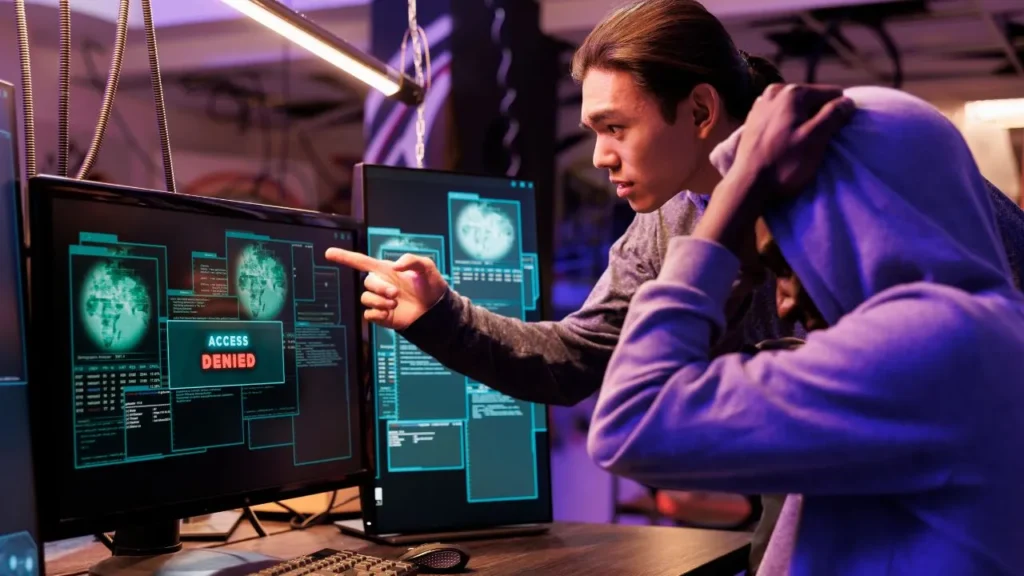Artificial Intelligence (AI) is revolutionizing cybersecurity, from automating tedious operations to improving third-party risk management procedures. But are we aware of all the hidden threats that come along with this powerful technology as we embrace it?
Artificial intelligence (AI) models are extremely useful in the battle against cyber threats such as malware and phishing attempts because they can recognize patterns and anomalies through the training of neural networks on large datasets.
Security experts may keep one step ahead of hackers with actionable threat intelligence from AI-powered systems, which can evaluate millions of inputs in real time.
Teams working in cybersecurity need to be aware of the possible hazards as they depend more and more on AI-driven solutions. The decision-making processes of AI systems can become opaque as they get more complicated, making it challenging to comprehend how they reach their judgments.
We can create more reliable and resilient systems that maximize the benefits of machine learning while minimizing its negatives by being aware of the possible dangers and limits associated with AI.
The Role and Benefits of AI in Cybersecurity
By automating processes, enhancing threat detection, and expediting incident response, artificial intelligence is transforming cybersecurity. The following are some main advantages:

Reduced Manual Tasks
- AI increases accuracy and saves time by automating the gathering of evidence for compliance.
- Process automation can flag non-conformities and lower the risk of cyberattacks by verifying every ninety days whether all certificates on production servers are updated.
Improved Threat Detection and Response
- Real-time data is analyzed by machine learning algorithms to find anomalies and possible risks.
- Updates on new hacks, vulnerabilities, and abnormal user behavior are provided by large language models such as ChatGPT.
- By limiting the attack surface, companies may specify threat response settings through API-driven interfaces.
- AI has the ability to automatically limit threats to stop data breaches and identify abnormalities in endpoint behavior.
Streamlined Incident Response
- During events, AI rapidly analyzes data to enable quicker containment and resolution.
- To effectively respond to complex threats, deep learning models may be trained on historical events.
- Triggerable processes automate containment measures, while generative AI updates trending occurrences and breaches.
- AI-powered note-taking ensures that all relevant information is recorded and that comprehensive reports are generated promptly.
- AI is used by security operations centers for threat hunting, incident management, and data protection.
Combating the rising threat of cybercrime requires the use of AI in cybersecurity. By utilizing AI’s ability to analyze data, identify dangers, and automate actions, organizations may improve asset protection and avoid expensive security breaches.

Common Misconceptions of Artificial Intelligence
Can AI Replace Humans?
The most widespread fallacy regarding AI is that technology will eventually supplant people. This anxiety is not new; throughout the 1980s and 90s, when personal computers gained popularity, people were concerned that these technological improvements would result in widespread unemployment.
New technologies bring about certain changes that might be disruptive at times, but ultimately they spur creativity and productivity. In the end, that results in the development of new industries and jobs.
Is AI Unbiased and Fair?
Another prevalent fallacy is the idea that AI is impartial and fair as human influence has no corrupting or impacting effects on it. Paradoxically, a sizable portion of the public thinks AI is unjust and prejudiced.
Actually, artificial intelligence (AI) is neither biased nor impartial; nonetheless, it may be swayed by people who create, implement, and choose the data that AI utilizes to learn.
Is AI Technology Complicated, Expensive, and Intrusive?
Although AI interests a lot of people, many also think it’s too costly or complex. (Or maybe they just don’t know how to get started.) This frequently occurs when someone gets too close to AI.
AI is a multifaceted field with a wide range of applications in cybersecurity, as was previously said. Find the ideal “amount” of AI and its use cases for your company by introducing it gradually.
The Unseen Risks of AI
The use of AI in cybersecurity is growing in popularity, but it’s important to recognize its limitations and the dangers of over-reliance. Although AI may automate and increase productivity for a variety of jobs, it is not a panacea.
1. False Positives and False Negatives
AI systems are prone to producing false positives and negatives, particularly given how quickly the danger picture is changing. AI could require constant fine-tuning and modifications to stay ahead of new dangers.
Take the case of an automated vulnerability patching system that, because of a lack of human control, fails to identify crucial new vulnerabilities.
2. Lack of Contextual Understanding
AI must develop the intuition and contextual knowledge that human specialists have. In intricate security circumstances, it could overlook minute details or make insufficient connections.
Artificial intelligence (AI) in cybersecurity is based on preset rules and algorithms that frequently lack context and might have unexpected implications. Organizations must combine automation with human control to reduce these hidden risks, making sure that the advantages of AI outweigh any potential disadvantages.
An excellent illustration of how automated security solutions can unintentionally impair operations without the right context and threat knowledge is the 2017 WannaCry epidemic. In response to the ransomware, several intrusion detection systems and firewalls applied wide rules, unintentionally obstructing normal network traffic and incurring needless collateral damage. This underscores the need of taking the possible effects of automated operations in cybersecurity into account.
3. Bias and Data Quality Issues
AI programs are only as good as the training data they use. Inaccurate conclusions and distorted outcomes might arise from inadequate or biased datasets. For instance, in real-world situations, an AI model trained on a dataset that underrepresents particular cyberattack types may be unable to identify those assaults.
4. Adversarial Attacks and Evasion Techniques
Cybercriminals can use adversarial approaches to take advantage of vulnerabilities in AI systems. They might tamper with input data or employ evasion strategies to get past AI-based security measures. An attacker creates malicious code that seems harmless to a malware detection system driven by artificial intelligence, enabling it to avoid detection.
5. Opacity and Lack of Explainability
A lot of artificial intelligence systems, especially those built on deep learning, are inexplicable and opaque. It might take some time to understand how AI models make judgments, which makes it difficult to validate and trust their results.
For instance, because the AI model lacks transparency, the security team is unable to ascertain why an AI system has flagged a normal behavior as harmful.
Ethical Considerations of AI
As previously said, although AI is not intrinsically unjust or prejudiced, humans may still control AI to perform as they choose. The outcome is only as trustworthy and accurate as the input data. AI will report 18+1 = 20 as the right response if you teach it that formula.
Content production is a common use case for generative AI. It can seem harmless to use AI to produce a policy, report, or blog post. However, if the material is false (or worse, exploited by outsiders), AI can mislead companies. The effective deployment of AI depends on ensuring openness and accountability regarding the organization’s usage of the technology.
Caution, particularly with automated decision-making systems, reduces the likelihood of introducing biases into AI. In 2018, it was discovered that Amazon had developed an automated system to evaluate resumes and provide hiring suggestions. However, the algorithm demonstrated bias against women, downgrading resumes that contained keywords linked to women.
Reuters reported in 2018 that resumes submitted to Amazon during a ten-year period served as the basis for the automated system’s learning.
Since the software sector has always been dominated by men, most resumes used to train the system were from male candidates. Consequently, the algorithm became biased against applications containing phrases commonly seen on women’s resumes, such as “women’s college” or participation in women’s groups.
This prejudice caused the automated system to inadvertently lower the resumes of female applicants, leading to gender discrimination throughout the hiring process. Thank goodness, Amazon ceased utilizing the technology after seeing the unfairness and possible legal repercussions. However, this is a great illustration of how AI might stray into immoral circumstances.
Best Practices for Implementing AI
Phase 1: Objectives and Use Cases
- Decide which particular jobs or procedures should be automated.
- Determine which concerns or problems the AI should address.
- Establish the intended result and advantages.
- Create a system to gauge the change.
Phase 2: Research and Define Options
- Analyze the technologies you now use.
- Determine any gaps and what needs to be added.
- Describe the integrations, triggers, and processes.
- Evaluate security and functionality.
As new AI technologies are developed, many free and open-source alternatives become accessible. Companies must include these easily obtained technologies in their security measures since they frequently circumvent corporate third-party risk management procedures. Will the organization ever find out if an employee signs up for a free ChatGPT account, uploads the strategic plan, and requests that ChatGPT build a slide deck? Don’t forget to incorporate regular training and oversight for novel instruments and atypical use.
Phase 3: Monitor and Scale
- Evaluate the AI’s outputs and functioning.
- Assess the AI’s efficacy.
- Optimize and modify AI to expand and get better
- Give instruction and training in AI.
How Does Your Organization Leverage AI for Cybersecurity?
Organizations need to be very deliberate about how they use, monitor, and modify AI in cybersecurity as it develops and becomes more complex. Finding the ideal balance between utilizing AI’s advantages and reducing its possible hazards is crucial.
Here are some crucial things to remember:
- Determine which security requirements are unique to your company and where AI can be most useful.
- Establish precise measurements and Key Performance Indicators (KPIs) to gauge how well your AI cybersecurity solution is working.
- Review and update AI models often to keep them responsive to emerging vulnerabilities and intrusions.
- Promote cooperation amongst AI specialists, cybersecurity specialists, and other stakeholders in your company.
- Exchange best practices, insights, and information to keep refining your AI cybersecurity plans.
We expect new and interesting use cases to surface as companies implement, monitor, and modify their use of AI, challenging the cybersecurity sector to remain vigilant. Take a look at our blogs for additional information or schedule a RiskOptics Solutions presentation right now to avoid doing it alone.